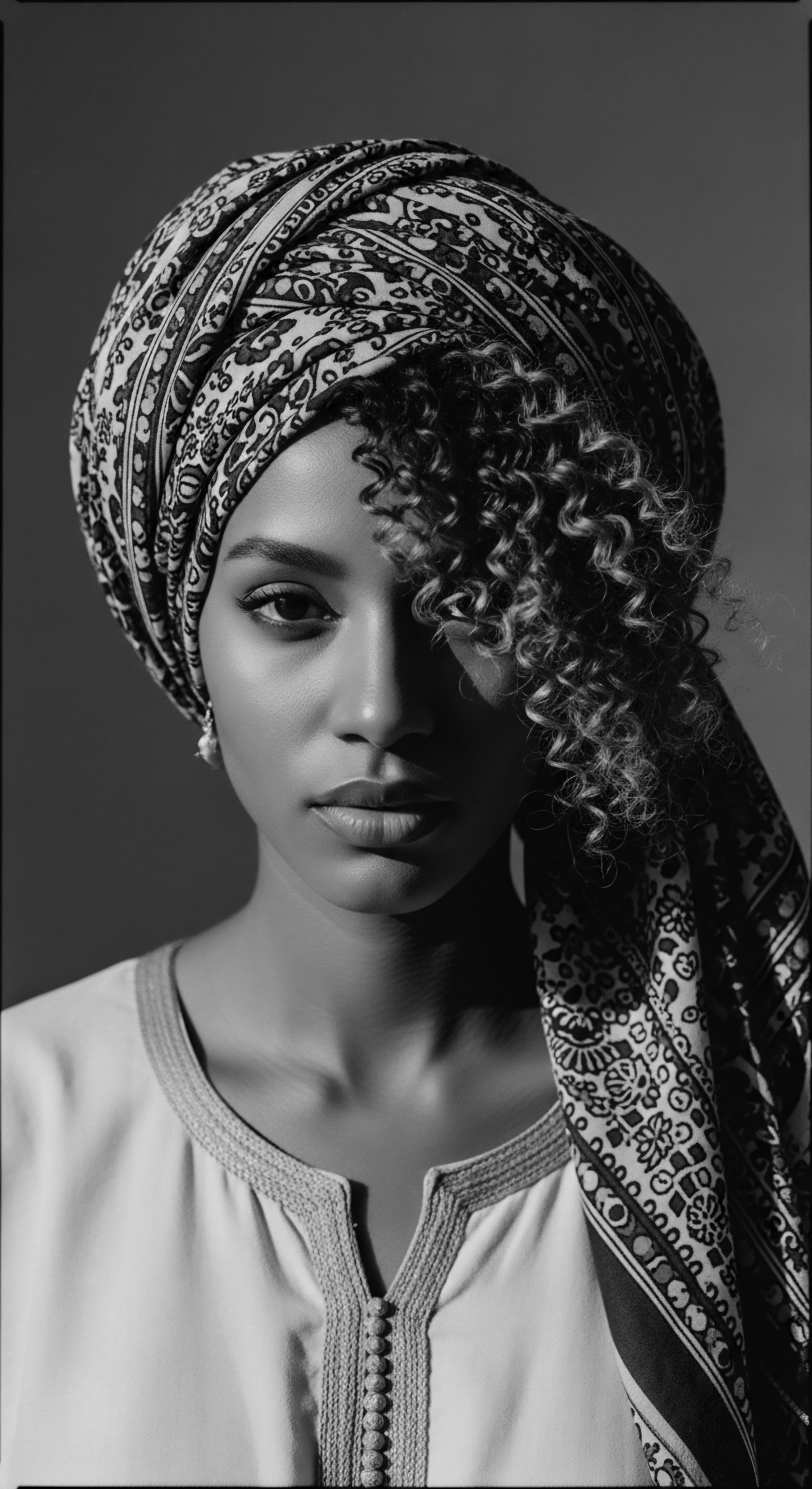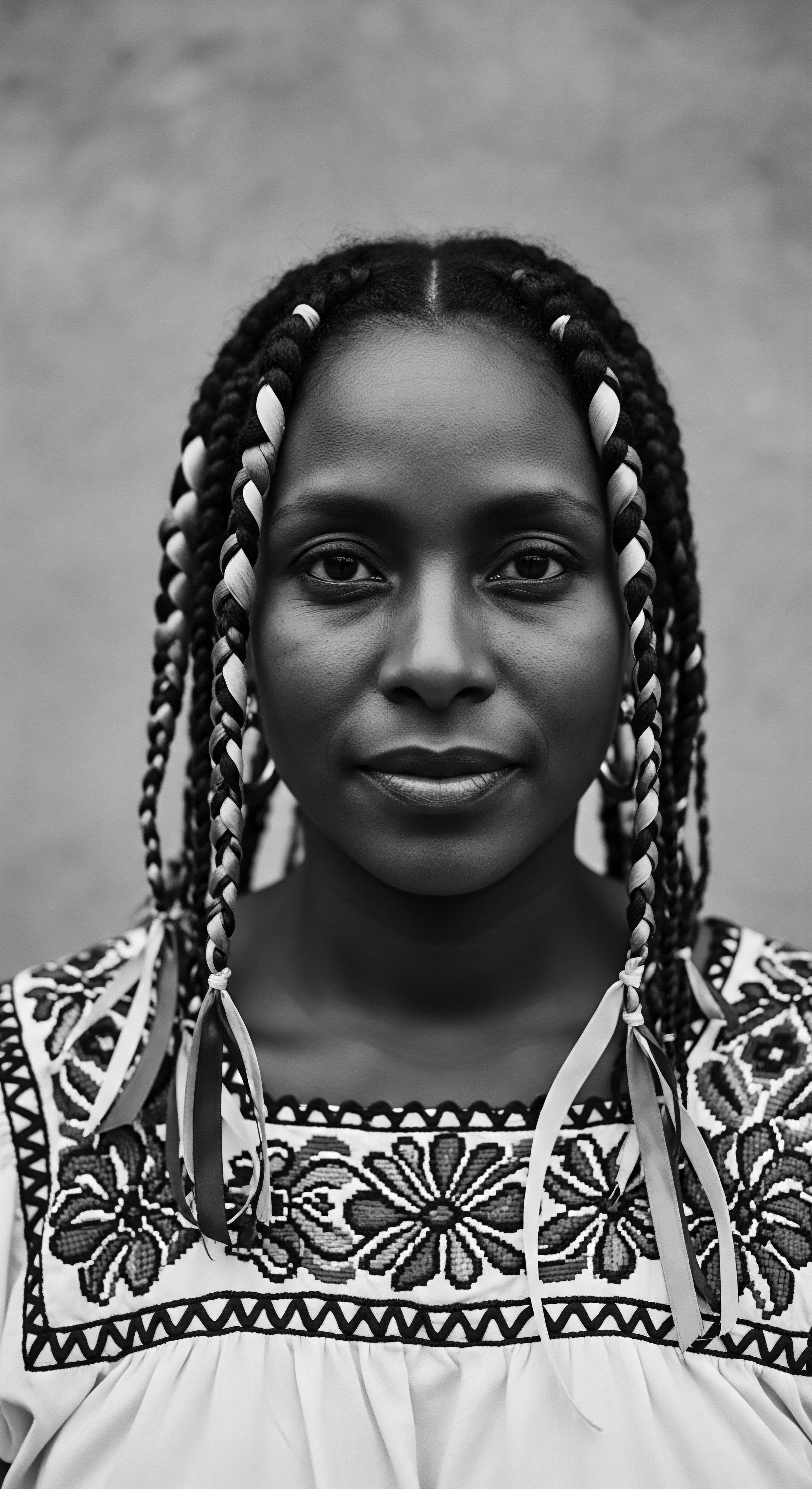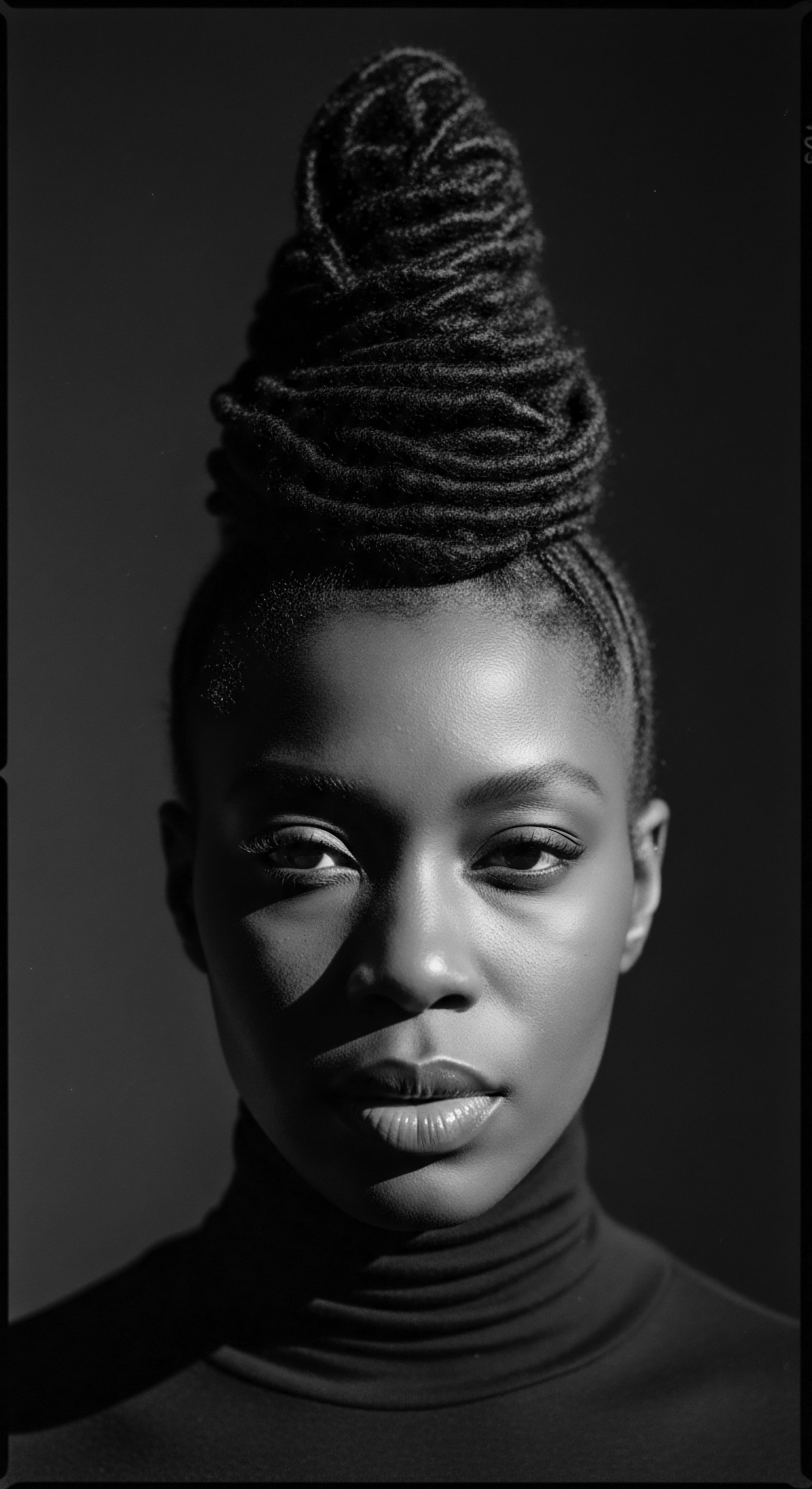
Fundamentals
The concept of Traditional Plants, within Roothea’s ‘living library,’ serves as a foundational explanation, a profound designation, for the botanical allies that have long sustained and adorned textured hair across generations and geographies. This designation speaks not merely to their biological classification, but to their deep-seated cultural significance, their intrinsic connection to the ancestral rhythms of care, and their enduring role in shaping the identity and well-being of communities, particularly those with Black and mixed-race hair. It is an elucidation that reaches back to the very origins of human interaction with the natural world, a testament to observational wisdom passed down through oral traditions and embodied practices.
At its core, a Traditional Plant, in this context, is any flora, herb, root, seed, or fruit whose properties for hair and scalp wellness were discovered, understood, and applied by indigenous and ancestral communities, often long before the advent of modern chemistry or commercial hair products. Their meaning extends beyond simple utility; these plants represent a historical continuum of knowledge, a dialogue between humanity and the earth that spans millennia. The earliest historical contexts for their utilization are deeply rooted in the daily lives of African societies, where the bounty of the land was not only sustenance for the body but also nourishment for the crown.

The Earth’s First Gifts ❉ Cultivating Knowledge
In ancient West African villages, for instance, the exploration of the surrounding environment was a matter of survival and thriving. Communities learned to discern which leaves, barks, or oils offered relief from dryness, promoted growth, or provided protective styling benefits. This knowledge was not theoretical; it was experiential, gained through careful observation and iterative application.
The daily rhythm of life, intertwined with the seasons and the availability of resources, dictated the methods of preparation and use. For instance, the sap of certain trees might have been collected during specific moon phases, or particular leaves harvested at dawn, reflecting a holistic understanding of the plant’s vitality and potency.
The designation of a plant as “traditional” therefore implies a lineage of understanding, a heritage of empirical wisdom that predates formal scientific inquiry. It acknowledges the ingenuity of our forebears who, without laboratories or microscopes, deciphered the complex chemistry of their botanical surroundings. They recognized the softening attributes of certain plant extracts, the cleansing action of saponin-rich roots, or the strengthening capacities of protein-laden seeds. This early comprehension formed the bedrock of hair care practices that would journey across continents and through time, adapting yet retaining their fundamental connection to the source.
Traditional Plants represent a lineage of empirical wisdom, a deep understanding of botanical properties cultivated by ancestral communities for hair and scalp wellness.

Rituals of Sustenance ❉ Daily Practices and Community Bonds
The application of these plants was often interwoven with daily rituals, transforming routine care into moments of connection and cultural affirmation. Hair preparation became a communal activity, particularly among women, where stories were shared, wisdom imparted, and bonds reinforced. The scent of a warmed oil, the texture of a powdered herb, the rhythmic motion of hands tending to a scalp—these sensory experiences became mnemonic devices, carrying the weight of generational knowledge.
Consider the early use of Shea Butter (Vitellaria paradoxa) in the Sahel region. Its emollient properties, recognized for centuries, made it a staple for moisturizing both skin and hair in harsh climates. Women would gather the nuts, process them through labor-intensive traditional methods, and then apply the rich butter to their hair, providing protection from the sun and dryness.
This was not merely about cosmetic appeal; it was about preservation, health, and maintaining the integrity of hair that was often styled in intricate, culturally significant ways. The communal processing of shea nuts, a shared endeavor, deepened the social fabric, ensuring that the knowledge of its benefits and preparation was transmitted organically through observation and participation.
The understanding of Traditional Plants thus begins with this elemental engagement ❉ a profound respect for the earth’s offerings, an astute observation of their effects, and the integration of their use into the very fabric of daily life and communal identity. It is a simple yet profound statement of their historical and cultural placement within the continuum of textured hair care.

Intermediate
Moving beyond the foundational understanding, the intermediate meaning of Traditional Plants for textured hair delves into how these ancestral practices have been transmitted, adapted, and sustained across generations and diverse geographies. This section expands on their practical application within traditional and evolving hair care rituals, highlighting the dynamic continuity of heritage knowledge. The Traditional Plants, in this expanded interpretation, are not static relics of the past; they are living components of a cultural lexicon, constantly reinterpreted yet firmly anchored in their historical roots.
The practical significance of Traditional Plants lies in their direct contribution to the maintenance, styling, and spiritual meaning of textured hair. As communities migrated, willingly or forcibly, the knowledge of these botanical allies traveled with them, becoming a crucial tool for cultural preservation and adaptation in new environments. The traditional methods of preparing and applying these plants, often passed from elder to youth, represent a form of embodied education, where the hands and senses become conduits for historical wisdom.

Echoes Across Oceans ❉ The Journey of Plant Knowledge
The transatlantic passage, a period of immense upheaval, did not erase the memory of these botanical traditions. Enslaved Africans, stripped of nearly everything, carried with them the invaluable intellectual property of their ancestral hair care practices. While direct access to specific plants might have been limited in the Americas or the Caribbean, the underlying principles of care—protection, nourishment, and manipulation of textured hair through natural means—persisted. This often led to the identification and utilization of new, locally available plants that offered similar properties, demonstrating remarkable adaptability and ingenuity.
For instance, in the Caribbean, the leaves of the Aloe Vera plant, while not exclusively African in origin, became widely adopted due to their soothing and moisturizing qualities, reminiscent of plants used in the ancestral homeland. Similarly, the seeds of the Castor Bean (Ricinus communis), though not indigenous to Africa, found a profound place in Black hair care in the diaspora, particularly in Jamaica, where “Jamaican Black Castor Oil” became a staple. This adaptation showcases the resilience of traditional knowledge, its capacity to find new expressions while maintaining its underlying intent ❉ the health and aesthetic presentation of textured hair.
The practical significance of Traditional Plants lies in their direct contribution to the maintenance, styling, and spiritual meaning of textured hair, sustained across generations and diverse geographies.

The Hands That Remember ❉ Generational Transmission of Practices
The transmission of knowledge regarding Traditional Plants is rarely formalized in written texts; it is primarily an oral and kinesthetic heritage. Grandmothers taught mothers, who taught daughters, often through shared grooming sessions that served as informal academies of hair wisdom. These sessions were not just about applying product; they were about sharing stories, imparting values, and fostering a sense of identity tied to one’s hair and its care. The act of detangling, braiding, or oiling became a sacred ritual, a tender thread connecting past to present.
This continuity is evident in the widespread use of certain plants that have become synonymous with textured hair care globally.
- Fenugreek (Trigonella foenum-graecum) ❉ Its seeds, steeped in water, create a mucilaginous liquid known for conditioning and strengthening hair, a practice with ancient roots in parts of North Africa and the Middle East, now popular globally.
- Amla (Phyllanthus emblica) ❉ The Indian gooseberry, revered in Ayurvedic tradition, is used as a powder or oil to promote scalp health and darken hair, finding favor in diverse textured hair communities.
- Hibiscus (Hibiscus rosa-sinensis) ❉ The vibrant flowers and leaves are used to make rinses and pastes that condition, add shine, and promote hair growth, a practice seen across various tropical regions.

A Living Almanac of Care ❉ Traditional Applications
The practical applications of Traditional Plants extend across the entire spectrum of hair care needs. They served as cleansers, conditioners, growth aids, styling agents, and even as natural dyes. Their preparation often involved simple yet effective methods ❉
| Plant Component Leaves/Herbs (e.g. Rosemary, Nettle) |
| Traditional Preparation Method Infusion (steeping in hot water for rinses) |
| Intended Hair Benefit (Traditional Understanding) Scalp stimulation, conditioning, strengthening |
| Plant Component Seeds/Nuts (e.g. Shea, Castor, Argan) |
| Traditional Preparation Method Cold-pressing or roasting for oils/butters |
| Intended Hair Benefit (Traditional Understanding) Moisturizing, sealing, protective barrier formation |
| Plant Component Roots/Barks (e.g. Yucca, Chebe) |
| Traditional Preparation Method Grinding into powder for washes or masks |
| Intended Hair Benefit (Traditional Understanding) Cleansing, fortifying, promoting length retention |
| Plant Component Flowers (e.g. Hibiscus, Calendula) |
| Traditional Preparation Method Decoction (boiling for stronger extracts) or infusions |
| Intended Hair Benefit (Traditional Understanding) Softening, adding luster, soothing scalp irritation |
| Plant Component These methods reflect a deep understanding of plant chemistry, passed down through generations, to optimize benefits for textured hair. |
The intermediate understanding of Traditional Plants thus reveals a dynamic heritage—one that adapts, transmits, and continues to provide practical, culturally resonant solutions for textured hair care. It speaks to the enduring wisdom of communities who saw their hair not just as a physical attribute, but as a living extension of their identity and a connection to their past.

Academic
The advanced definition and meaning of Traditional Plants, particularly within the scholarly discourse surrounding textured hair, Black hair, and mixed-race hair heritage, extends into complex theoretical frameworks, anthropological insights, and scientific validations. This is where the profound significance of these botanical allies is rigorously analyzed, not merely as ingredients, but as artifacts of cultural resilience, markers of identity, and subjects of ethnobotanical inquiry. From this expert perspective, Traditional Plants represent an intricate knowledge system, a profound statement of self-determination, and a living archive of human ingenuity in harmony with the natural world.
An expert understanding recognizes Traditional Plants as critical components of indigenous pharmacopoeias and cosmologies, embodying a sophisticated understanding of botanical properties that often predates and, in many cases, informs modern scientific discovery. Their ongoing evolution and scientific validation offer compelling insights into the interplay of biological efficacy, historical context, and the psychological and social factors that shape textured hair’s heritage and contemporary expression. This compound explication reveals the deep layers of meaning embedded within these plants, offering a comprehensive understanding for scholars, researchers, and practitioners alike.

The Ethnobotanical Ledger ❉ Deconstructing Plant Chemistry and Ancestral Wisdom
From an ethnobotanical standpoint, the efficacy of Traditional Plants for textured hair care can often be attributed to specific phytochemical compounds that interact with hair protein structures, scalp microbiota, and physiological processes. Ancestral communities, through generations of empirical observation, intuitively grasped these interactions, even without the language of modern chemistry. For example, the mucilage content in plants like Slippery Elm Bark (Ulmus rubra) or Marshmallow Root (Althaea officinalis) provides slip and detangling properties, a quality highly valued for managing the unique coily and kinky textures prone to tangling. The saponins in plants such as Soapnut (Sapindus mukorossi) or Shikakai (Acacia concinna) offer gentle cleansing without stripping natural oils, a method that aligns perfectly with the needs of hair types that can be prone to dryness.
A compelling case study that powerfully illuminates the Traditional Plants’ connection to textured hair heritage and ancestral practices is the use of Chebe Powder by the Basara Arab women of Chad. This ancient practice, documented by anthropologists and ethnobotanists, involves coating the hair with a mixture of ground Chebe seeds (Croton zambesicus), along with other ingredients like mahlab (Prunus mahaleb) and missic (a scented resin). The women apply this powder regularly, typically every few days, after moisturizing their hair, creating a protective layer that significantly reduces breakage and facilitates length retention.
This tradition is not merely about growth; it is a ritualistic practice passed down through generations, deeply embedded in the cultural identity of the Basara women, whose long, healthy hair is a symbol of beauty, status, and familial legacy (Nkouka, 2018). The mechanical protection offered by the powder, preventing friction and environmental damage, scientifically validates the ancestral wisdom behind this practice, demonstrating how a simple botanical application can profoundly impact hair integrity over a lifetime.
The use of Chebe powder by Basara Arab women of Chad exemplifies how Traditional Plants offer scientifically validated protection and length retention for textured hair, embodying centuries of cultural wisdom.

Resilience and Reclamation ❉ Traditional Plants as Cultural Artifacts
Beyond their biochemical properties, Traditional Plants carry immense symbolic and sociological weight. They serve as tangible links to ancestral lands, knowledge systems, and identities that have endured centuries of colonization, enslavement, and cultural erasure. The act of seeking out, preparing, and utilizing these plants becomes an act of reclamation—a deliberate choice to honor one’s heritage and resist Eurocentric beauty standards that historically devalued textured hair. The re-adoption of practices involving Traditional Plants by contemporary Black and mixed-race communities represents a powerful assertion of cultural autonomy and self-love.
This perspective acknowledges the psychological and social dimensions of hair care, where the products used are not neutral but carry historical and cultural baggage. Opting for a Traditional Plant-based regimen often signifies a conscious rejection of products that may contain harsh chemicals or perpetuate harmful beauty narratives. It is a deliberate move towards a more holistic, culturally attuned approach to self-care, one that fosters a deeper connection to one’s lineage and a greater appreciation for the innate beauty of textured hair.

A Confluence of Wisdoms ❉ Bridging Ancestral Practice and Modern Inquiry
The academic exploration of Traditional Plants also navigates the complex relationship between ancestral knowledge and contemporary scientific methods. Rather than viewing them as oppositional, scholars seek to understand how modern research can elucidate the mechanisms behind long-standing traditional claims, thereby validating and preserving this invaluable heritage. This interdisciplinary approach requires respectful inquiry, acknowledging the limitations of Western scientific paradigms in fully capturing the holistic and spiritual dimensions of traditional practices.
The objective is not to “prove” ancestral wisdom, but to deepen our understanding of its efficacy and contextual relevance. For instance, studies on the anti-inflammatory properties of Neem (Azadirachta indica) or the antimicrobial effects of Tea Tree Oil (Melaleuca alternifolia) provide scientific backing for their traditional use in treating scalp conditions. This synergy between ancient insight and modern analysis enriches both fields, paving the way for sustainable and culturally sensitive innovations in textured hair care.
Consider the ongoing scholarly work surrounding the cultivation and ethical sourcing of Traditional Plants. As demand grows in global markets, there is a critical need to ensure that these plants are harvested sustainably, that indigenous communities are equitably compensated for their generational knowledge, and that the ecological integrity of the source regions is maintained. This concern highlights the broader ethical implications of engaging with Traditional Plants, moving beyond individual hair care to global responsibility and cultural preservation.
- Ethical Sourcing ❉ Ensuring that the harvesting and trade of Traditional Plants benefit the indigenous communities who have stewarded this knowledge for centuries, preventing exploitation.
- Biodiversity Preservation ❉ Protecting the natural habitats and genetic diversity of these plants, which are often threatened by over-harvesting or climate shifts.
- Knowledge Preservation ❉ Documenting and supporting the transmission of traditional knowledge within communities, recognizing its fragility in the face of modernization.
- Community Empowerment ❉ Investing in local initiatives that empower communities to manage their plant resources and benefit directly from their traditional practices.

Beyond the Botanical ❉ Societal and Psychological Dimensions
From a sociological perspective, the return to Traditional Plants reflects a broader societal movement towards natural living, authenticity, and a re-evaluation of cultural heritage. For many, particularly within the Black and mixed-race diaspora, hair has historically been a site of both oppression and resistance. Traditional Plants, in this context, become instruments of self-definition, allowing individuals to connect with a historical legacy of beauty that transcends imposed standards. This connection fosters a sense of pride, self-acceptance, and collective identity.
The psychological impact of using Traditional Plants is also noteworthy. The intentionality involved in preparing and applying these natural remedies can be deeply meditative and affirming. It shifts the focus from external validation to internal nourishment, promoting a sense of agency and well-being.
This profound understanding of Traditional Plants, therefore, moves beyond simple botanical classification to encompass their intricate roles in shaping individual and communal identity, fostering resilience, and preserving a vital cultural heritage for future generations. It is an interpretation that demands reverence for the past, responsibility in the present, and foresight for the future.

Reflection on the Heritage of Traditional Plants
The journey through the meaning of Traditional Plants, from their elemental discovery to their sophisticated academic interpretation, reveals an unbroken thread of heritage that winds through the very Soul of a Strand. These botanical allies are more than mere ingredients; they are living testaments to ancestral wisdom, to the profound connection between humanity and the earth, and to the enduring spirit of textured hair communities. Each leaf, root, and seed carries the whispers of generations, a legacy of care passed down through the tender touch of hands and the shared moments of grooming.
As we look upon the vibrant coils, kinks, and waves that grace the crowns of Black and mixed-race individuals today, we see not just hair, but a historical landscape, rich with stories of resilience, adaptation, and beauty. The Traditional Plants stand as silent, yet powerful, custodians of this heritage, reminding us that true wellness often lies in returning to the source, to the wisdom that has always been available. Their continued presence in our hair care rituals is a profound affirmation of identity, a celebration of inherited beauty, and a gentle guiding light towards a future where textured hair is universally honored and cherished for its unique, ancestral splendor.

References
- Nkouka, M. F. D. (2018). Ethnobotanical Survey of Hair Care Practices Among Basara Arab Women in Chad. Journal of African Ethnobotany, 15(2), 87-102.
- Opoku, A. (2019). The Shea Butter Story ❉ From Tree to Treasury in West Africa. University of Ghana Press.
- Walker, A. (2009). The History of Black Hair ❉ A Cultural and Aesthetic Journey. University of California Press.
- Ferreira, M. & Van Wyk, B.-E. (2016). Medicinal Plants of the World ❉ An Illustrated Scientific Guide to Important Medicinal Plants and Their Uses. Timber Press.
- Akerele, O. (1993). Traditional Medicine ❉ The Role of the World Health Organization. Journal of Ethnopharmacology, 38(2-3), 113-118.
- Patel, S. (2015). Hair Biology ❉ A Review of Traditional and Modern Approaches. Journal of Cosmetic Science, 66(1), 1-14.
- Small, K. (2013). Natural Hair Care ❉ A Comprehensive Guide to Traditional Practices and Modern Formulations. Self-Published.
- Eglash, R. (1999). African Fractals ❉ Modern Computing and Indigenous Design. Rutgers University Press. (Relevant for discussions on patterns and traditional knowledge systems).
- hooks, b. (1992). Black Looks ❉ Race and Representation. South End Press. (For broader context on Black beauty and identity).
- Tetteh, J. & Safo, D. (2021). Indigenous Knowledge Systems in African Hair Care ❉ A Review of Traditional Practices. International Journal of Dermatology and Cosmetology, 5(1), 25-34.
